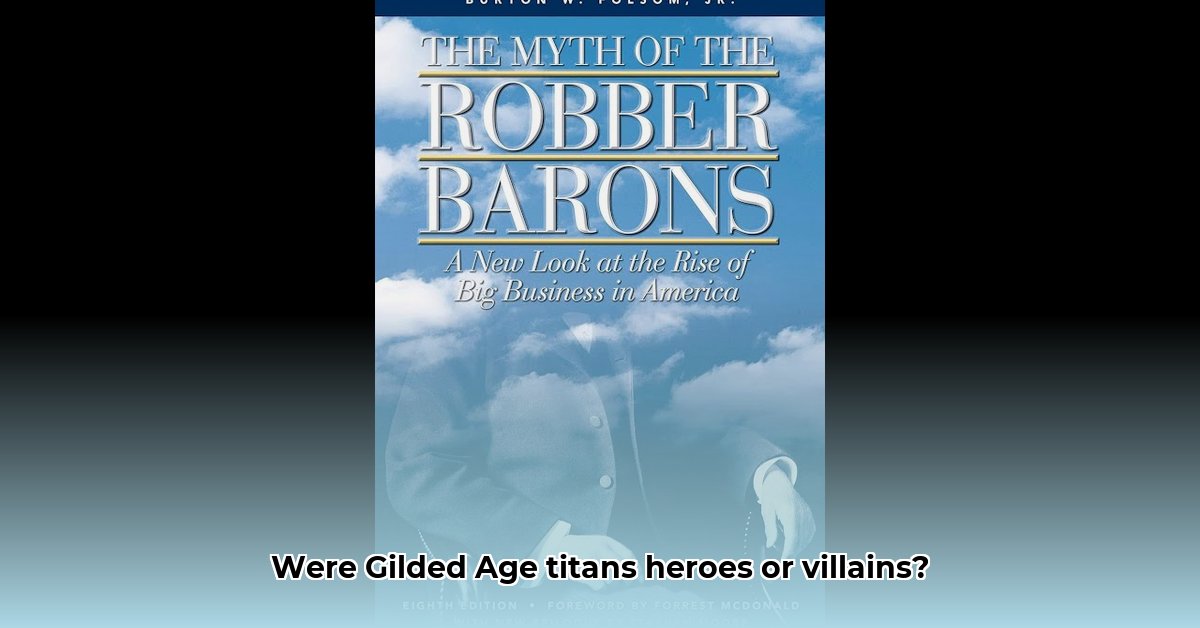
The Gilded Age, a period of immense industrial growth in America from roughly 1870 to 1900, is often painted with a broad brush: a saga of “robber barons,” ruthless capitalists who amassed fortunes through exploitation and manipulation. But this simplistic narrative, while emotionally resonant, obscures a more complex reality. A nuanced examination reveals a crucial distinction between two types of entrepreneurs: those who built their empires through innovation and competition, and those who thrived on political connections and government favors. This article explores this dichotomy, challenging the conventional wisdom and offering a more balanced perspective on this pivotal era in American history.
Separating Myth from Reality: Market Mavericks vs. Political Players
The traditional image of the robber baron conjures up figures like Cornelius Vanderbilt and John D. Rockefeller, titans of industry whose names are synonymous with immense wealth. However, historian Burton Folsom, in his work The Myth of the Robber Barons, argues for a more refined understanding. He distinguishes between "market entrepreneurs," who achieved success through efficiency, innovation, and cutthroat competition, and "political entrepreneurs," who leveraged government connections and subsidies to gain an unfair advantage.
This isn't a simple "good guys versus bad guys" dichotomy. Both groups contributed to the dramatic economic transformation of the era, but their methods and lasting impacts differed significantly. Market entrepreneurs like Vanderbilt, Rockefeller, and Andrew Carnegie (steel) focused on improving productivity, lowering costs, and expanding markets. Their innovations—from steamboats to oil refining to mass steel production—reshaped American life, offering consumers better products at more affordable prices. Was their pursuit of profit always ethical? Certainly not. But their innovations undeniably fueled economic growth and improved living standards for many. Wasn't the widespread availability of relatively inexpensive oil a benefit for many?
In contrast, political entrepreneurs prioritized securing government favors, subsidies, and protections from competition. Their success wasn't driven by innovation but by influence, often at the expense of broader economic efficiency and fairness. They created an environment where cronyism flourished, potentially stifling genuine innovation and competition.
The Government's Role: A Catalyst for Both Success and Failure
The government itself played a multifaceted role, sometimes inadvertently exacerbating the very problems it sought to solve. Policies aimed at stimulating economic growth, such as land grants for railroads, could be manipulated by political entrepreneurs, creating an uneven playing field. Conversely, some government actions, such as those associated with Andrew Mellon's tenure as Secretary of the Treasury under President Harding, emphasized tax cuts intended to stimulate economic growth (a theory with modern echoes in “supply-side economics”). However, the effectiveness and consequences of these policies remain subjects of ongoing historical debate.
Did Mellon's policies truly fuel the economic boom of the 1920s, or were other factors at play? This question highlights the complexities inherent in attributing cause and effect in historical analysis. The interplay between government actions and entrepreneurial strategies shaped the landscape of the Gilded Age, both aiding and hindering economic progress.
The impact of government subsidies on profitability is a key element in understanding this period. Political entrepreneurs initially benefitted from subsidies, gaining a short-term advantage. But this often led to inefficiency and inflated costs, eventually undermining the long-term sustainability of their ventures. Market entrepreneurs, while facing greater initial challenges, built more resilient businesses based on sound principles of competition and customer satisfaction, ultimately achieving greater and more lasting success.
Reframing the Narrative: A More Balanced Perspective
The simplistic "robber baron" narrative, while emotionally satisfying, provides an incomplete and often misleading picture of the Gilded Age. It overlooks the crucial distinctions between entrepreneurs who achieved success through innovation and those who relied on political maneuvering. A more accurate understanding requires a nuanced analysis, acknowledging the complexities of market forces, government intervention, and individual entrepreneurial strategies. By recognizing this complexity, we can move beyond simplistic labels and develop a more profound understanding of this era and its enduring relevance to contemporary economic and political debates.
The legacy of the Gilded Age is multifaceted and far-reaching. It reminds us of the potential benefits of both innovation and competition, but also of the dangers of unchecked political influence and cronyism in shaping economic outcomes. Understanding this era requires separating the myths from the realities, acknowledging both the successes and the failures, and appreciating the complex interplay of forces that shaped the American economy. This more nuanced understanding allows for a more informed discussion of the issues that continue to shape our modern economy.